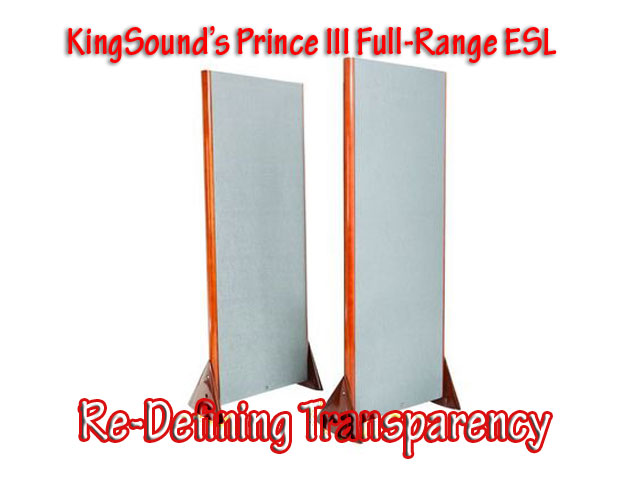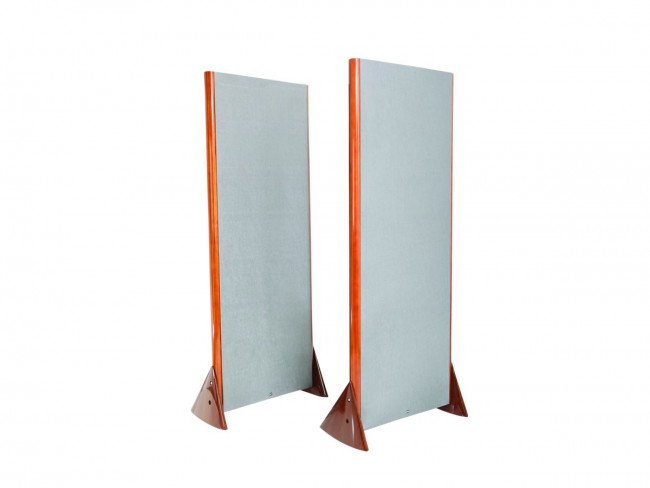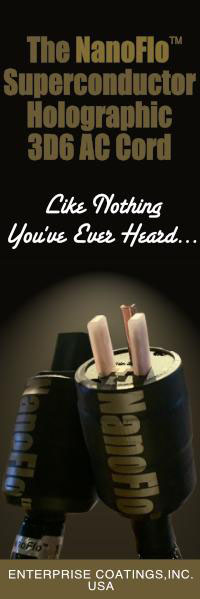KingSound Prince III

Ears Wide Open
If you are the type of listener that values transparency, coherence, broad, deep soundstaging, imaging precision, and micro-dynamic nuance above all else, then brother, do I have just the right speakers for you: KingSound’s impressive Prince III full-range electrostatics. Standing nearly six feet high, almost two feet wide, but just over two inches deep (minus their custom stands/footers) these large but not domineering panels have transformed how this reviewer listens to music. They are amongst the most transparent to sources devices I have ever heard, and make listening to works of almost all types a pure joy.
They sound superb in the semi near-field – that is about 9 feet from the listening position – but even better when one is seated 11 or 12 feet from their front planes. In my 15’ x 18’ listening room, I was able to place the speakers about 3.5’ away from the back wall, a necessity with dipole radiators. They make all-too-clear the differences between cables, front-end electronics (whether digital and analog), and good versus poorly recorded sources. They capture subtle differences in instrumental tone and timbre far better than I expected, and with superb smoothness and an overall open, airy sound. The Prince IIIs are also highly inefficient devices, demanding gobs and gobs of clean power, especially when reproducing dynamically robust classical fare. They boast a relatively narrow sweet spot, but retain a neutral tonal balance and reasonably wide dynamics when all of the stars align.
They sound better on naturally balanced jazz and classical recordings than on rock standards, but do not render the latter, or well-recorded pop for that matter, unlistenable. Quite the contrary. Although pop and rock recordings lack the ultimate in weight and slam that the best dynamic driver systems can deliver, Stevie Wonder still sounds like Stevie Wonder through the Prince III’s, the Talking Heads still sound like the Talking Heads, albeit with a bit less oomph than one will hear from a comparably priced B&W, Aerial, Focal or Dali floor-stander.
But, where the Princes play, from about 40Hz up to infinity, they play with startling speed, openness, and indeed a sheer beauty that sounds, to my ears, quite remarkable and, at times life-like. However, if your idea of accuracy, beauty and fidelity involves single-ended tube amps, horn loudspeakers and vintage Thorens idler drive turntables, the Prince IIIs may not be your cup of tea. The same holds true for fans of casket-sized aluminum, phenolic resin, or wood and steel boxes from the likes of Magico, Wilson and Sonus Faber. Despite their considerable strengths, the Prince IIIs will never match the power, scale, bass reach, and impact of the best dynamic speakers. However, if what you value is transparency, coherence, openness and micro-dynamic subtlety, the acknowledged strengths of dynamic drivers won’t matter much to you anyway. 
Putting the Pieces Together
The Prince IIIs arrived in two large wooden crates, one a little longer than the length of the speakers, the other about 20 inches square. The longer container naturally houses the delicate electrostatic panels and their protective fabric-covered screens (light grey), while the smaller square box houses the heavy plastic (or perhaps resin) footers and the lovely outboard crossover/transformer boxes. Electrostatic speakers are, by design, high impedance devices. Dynamic speakers, by contrast, are relatively low impedance devices that typically require the use of high current amplifiers to sound their best. Because of their high impedances, all electrostatics (with the exception of the “transformer-less” Acoustats of old) require the use of a transformer to lower their high impedances sufficiently to allow them to work with modern amplifiers. Again, they are, by design, not so much current hungry devices as they are voltage hogs. They tend to need lots of watts to overcome lower-than-average sensitivity levels. They do boast low impedances – typically less than one ohm – at or around 20khz, but since there is relatively little musical energy in that frequency range, drive difficulties are ameliorated. Many audiophiles prefer to drive electrostatic speakers with tubes, a preference apparently shared by the folks at KingSound given the wide range of tube amps that the firm builds.
Unfortunately, I have little in-home experience with tube amps, a situation I hope to remedy in the near future (Bob Carver, expect a phone call from me any day now). For the nonce, I made do with the high current Cambridge Audio 840W power amp. The 840W had no trouble driving the KingSounds to satisfying levels, but it ran hotter than hell, necessitating the purchase of a small USB-powered fan to keep things cool.
Speaker set-up proved pretty straight-forward, even more so after I received an email from KingSound’s Simon Lai containing clearly-written set-up instructions. Regarding speaker set-up and overall product execution, I have two quibbles. One concerns the heavy, generally well-made stabilizing footers. These triangle-shaped footers are heavy affairs that appear to be constructed of some kind of thermo-plastic. Each footer features two pre-drilled screw holes (one at footer top, the other at the bottom) and “longish” screws that run through the footers to secure each to the speaker panels. Although the footers usefully elevate the speakers off the ground and provide the necessary clearance for the heavy-duty cable that runs from the external crossover/transformer box to the speaker bottom, one of the pre-drilled speaker holes was foreshortened meaning that the one of the long footer-to-speaker screws stood proud of the footer by about an inch instead of mounting flush with the footer surface.
In all fairness, this did not appear to impact overall speaker/footer stability. It did, however, look somewhat clumsy and detracted a bit from pride of “ownership” (I use the term “ownership” loosely here since I don’t actually own the speakers). More to the point, it denotes a need on KingSound’s part to pay a bit more attention to final finish details, especially at the Prince IIIs $10,000 per pair price point. My second quibble concerns the driver mounting substrate, here, seemingly inexpensive (re: cheap) plywood, painted black. While the plywood mounting platform did not result in any sonic penalties that I could detect, given the Prince III’s price, I would have expected the use of a more elaborate mounting material, say higher quality MDF, for example.
By way of contrast, the superbly executed outboard crossover/transformer boxes resemble medium-sized power amplifiers. Housed in attractive, gunmetal grey aluminum enclosures with thick front and rear face plates, each box tips the scales at roughly sixteen pounds. The rear panel contains four high-quality speaker binding posts that facilitate bi-wring. The posts accept bare wires, bananas, and spades. I used Silnote’s outstanding Orion M2 speaker cables with spade terminations for this review. The speaker mounting terminals proved exceptionally easy to use; I could bear down on them with plenty of force to obtain the securest possible cable/binding post interface.
The crossover/transformer front panel features a large, multi-pinned receptacle protected by a plastic flip-down cover. The heavy plastic cover flips upward to reveal a large multi-pinned female receptacle that accommodates a large, custom designed male input plug manufactured by a company called Winsten, a firm that I know nothing about. A heavy speaker cable runs from the crossover/pus box to the base of the speaker. A lovely bamboo-enclosed 12v wall wart supply provides power to the crossover/transformer box. I understand that some reviewers have elected to replace the supplied bamboo wall wart with more elaborate outboard power supplies, but I used the units sent to me for this review.
As far as electrostatics go, the driver arrangement seems pretty straightforward. Each speaker panel houses seven bass panels (roughly 12” by 6.5” each) and seven tweeter panels (each roughly 6.5” x 3”). The drivers themselves are made of ultra-thin conductive film and covered by protective perforated stators, these painted green. According to KingSound, “[t]he electrically charged ultra-thin conductive film diaphragm is tensioned and placed close between two metal grids. When a high voltage audio signal is applied to the metal grids, the diaphragm moves in response to the signal, moving towards the grid which at that instant is oppositely charged, and away from the grid which has the same charge as the diaphragm. The diaphragm responds in an essentially linear manner, producing sound waves which are a very accurate reproduction of the original sound.”
The nearly six-foot high by two-foot wide dipole functions as a line source, meaning that the speaker’s initial soundwave consists primarily of direct sound with little in the way of direct-to- reflected sound. This is followed a millisecond later by the speaker’s out-of-phase rear-wave component. Soundwaves emanating toward the speaker’s edge therefore tend to cancel. This edge effect cancellation feature, when combined with the relatively large electrostatic panel radiating surface, minimizes side output artifacts relative to the performance of conventional dynamic driver loudspeakers (at least with those not designed to minimize this effect). This side output cancellation feature reduces side-wall reflections that can smear musical details and compromise important sound-staging cues and imaging stability.
This accounts for the unusually open and spacious sound that electrostatic speakers are known for. The downside is that the Princes, like most electrostatics, generate a rather narrow sweet spot. I detected significant spatial shifts when my head moved outside of this narrow sweet spot, but overall tonality was largely unaffected. Within that range (about 10 to 12 inches), imaging and sound-staging cues were superbly stable and palpable. However, even subtle head shifts outside of the “zone” resulted in notable changes. While the soundstage retained its overall spaciousness when I sat outside the “zone” (but not too far), image specificity was greatly diminished.
Sonic Impressions
Straight out of the box, the Prince IIIs displayed all of the virtues of good electrostatic speakers – speed, coherence, openness, and superb transparency – and many of the breed’s traditional weaknesses as well – limited bass output, tonal thinness and dynamic flatness. Clearly, my Prince IIIs had not undergone any extensive break-in before arrival. Still, their superb reproduction of transients, their clarity and startling transparency proved addictive. Switching back to my long-term references, PSB’s Platinum M2s, showed just how much more transparent the Prince III sounded. In particular, the width and depth of the reproduced soundstage swelled to enormous proportions. Ambient cues, soundstage height, and the placement of instruments within the recorded space sounded at times downright spooky. Instruments started and stopped with breakneck speed and clarity.
On the other hand, before full break-in, the speakers sounded, as noted above, noticeably lean, even in the presence of the lushly-voiced Parasound JC-3+ phono stage. Miles Davis still sounded like Miles Davis, but with a bit of meat missing from the bone. More noticeable in the early stages of this review was the distinct sense that the reproduced soundstage was cut not from whole cloth but rather from individual fabric swaths sewn into sonically discreet panels. However, after about 150 hours of playing time, the sound took on a more relaxed presentation. Instrumental timbres warmed, the mid-bass region in particular gaining in depth, texture and weight. Soundstage depth cues emerged from further within the recorded plenum, the initial patchwork sound-field now replaced with one of greater cohesion and continuousness.
Electrostatic loudspeakers have a well-earned reputation for producing big, vibrant soundstages of impressive width, depth and height, but often at the expense of imaging specificity. Fans of mini-monitors and even large dynamic driver systems noted for their imaging stability and focus (the big Wilson models come to mind here) might well find the typical electrostatic speaker to sound enjoyably big and open, but less precise and focused when it comes to imaging (the placement of individual instruments and performers within the reproduced sound-field). Imagine my surprise, then, when I discovered that the Prince IIIs imaged almost as well as they projected a wide-open soundstage. Although they did not offer quite the razor-sharp imaging focus of the finest minis, their placement of individual instruments and performers, as well as clusters of instruments, within the recorded ambient field remained stable and precise at all times, at least so long as I remained in listening sweet spot.
In my review of Silnote’s superb line of cables, I ruminated at length on the importance of a given component’s (and system’s) ability to reproduce accurately musical transients, both dynamically and temporally. As I noted then, it is through these difficult-to-reproduce transient cues that sensitive listeners learn to distinguish say a trumpet from a cornet, or a harpsichord from a piano. I praised the Silnotes for their ability to capture the way the initial musical transient (and sometimes end transient) flows naturally into the sustain and thence into the sonic decay as a continuous event. Much of what I praised the Silnotes for applies with equal and perhaps greater measure to the Prince IIIs. They are simply unrivaled in their ability to reproduce musical transients and accompanying sustains and decays. High-hats, snares and cymbals resound with crystal clarity, bass plucks snap and crackle with lightning speed, and notes resonate off the piano keyboard and recede into the musical ether in wholly realistic fashion.
Perhaps most impressive is the way the Prince IIIs reproduce drums and related rhythm instruments. Given my love of mini monitors, one area where almost every example of the breed falls short is in their ability (or inability) to reproduce in a realistic manner the drum kit’s dynamic envelope, and perhaps more importantly, the kit’s unique timber. Through your typical mini, the sound of most drum kits comes across as dynamically compressed and a bit “hooded”. I suspect that this is the result of the dynamic drivers – especially your typical 5 or 6-inch mid-bass driver – giving up the ghost well before the drum kit can achieve full dynamic and tonal expression in a given system. There’s only so much sound small drivers can emit after all.
By way of contrast, electrostatic speakers radiate sound over virtually their entire exposed surface areas, front and back. So while they are typically less sensitive, and unable to match the overall maximum loudness capabilities of many dynamic driver systems, where they play, they do so with less distortion and compression, that is until they reach their loudness range limits. Because electrostatic drivers are less prone to dynamic compression (and related distortions) when operating within their loudness and frequency-range limits, the sound of a drum kit comes across as more realistic than one hears with your typical compact or mini, even some very well designed models, operating over the same frequency range.
 So, on something like The Peacocks from Bill Evans’ superb early 80s release You Must Believe in Spring [Warner Brothers 8122-73179-2], when drummer Eliot Zigmund delicately whirls cymbal and high-hat traces, but punctuates the ethereal ambience with the sudden thump of the bass drum, one hears not just the “thump” of the drum but also the sound of the instrument’s skin as the foot pedal strikes, the resultant combination reproduced as an uninterrupted whole from initial transient thud to earthy decay. This masterful reproduction of the music’s distinct temporal and tonal footprints made listening to the Evans’ disc a revelation and a highly addicting experience.
So, on something like The Peacocks from Bill Evans’ superb early 80s release You Must Believe in Spring [Warner Brothers 8122-73179-2], when drummer Eliot Zigmund delicately whirls cymbal and high-hat traces, but punctuates the ethereal ambience with the sudden thump of the bass drum, one hears not just the “thump” of the drum but also the sound of the instrument’s skin as the foot pedal strikes, the resultant combination reproduced as an uninterrupted whole from initial transient thud to earthy decay. This masterful reproduction of the music’s distinct temporal and tonal footprints made listening to the Evans’ disc a revelation and a highly addicting experience.
 And despite a touch of leanness, the Prince IIIs allow tonal colors to shine unimpeded. Through them, one can easily discern the tonal differences between various components and sources. This transparency to sources was evident across the board. WithPro-ject’s superb Phono-Box RS boosting my low-output Dynavector’s DV-20X2 mc cartridge, Daniel Barenboim’s sensitive but overly-ripe sounding recording of Schoenberg’s Verklärte Nacht (Transfigured Night) (Schoenberg: Verklarte Nacht/Wagner: A Siegfried Idyll /Hindemith: Trauermusik [Angel S-36484]) sounds superb. Seductively airy and rich, the Barenboim disk exhibits what I described in the Silnote cable review as a “whole milk” creaminess. By way of contrast, through the Parasound JC-3+ phono preamp (review forthcoming), the same recording, while still beautiful, made no pretense of adhering to a neutral balance. With its lush, “technicolor” tonal palette, the JC-3+ exacerbated the Schoenberg’s inherent warmth too much, resulting in a darker, almost “syrupy” balance. The Prince IIIs revealed these shifts in tonal perspective and coloring with night-and-day clarity.
And despite a touch of leanness, the Prince IIIs allow tonal colors to shine unimpeded. Through them, one can easily discern the tonal differences between various components and sources. This transparency to sources was evident across the board. WithPro-ject’s superb Phono-Box RS boosting my low-output Dynavector’s DV-20X2 mc cartridge, Daniel Barenboim’s sensitive but overly-ripe sounding recording of Schoenberg’s Verklärte Nacht (Transfigured Night) (Schoenberg: Verklarte Nacht/Wagner: A Siegfried Idyll /Hindemith: Trauermusik [Angel S-36484]) sounds superb. Seductively airy and rich, the Barenboim disk exhibits what I described in the Silnote cable review as a “whole milk” creaminess. By way of contrast, through the Parasound JC-3+ phono preamp (review forthcoming), the same recording, while still beautiful, made no pretense of adhering to a neutral balance. With its lush, “technicolor” tonal palette, the JC-3+ exacerbated the Schoenberg’s inherent warmth too much, resulting in a darker, almost “syrupy” balance. The Prince IIIs revealed these shifts in tonal perspective and coloring with night-and-day clarity.
By the same token, the Prince IIIs make abundantly clear why I hate many early digital recordings: most don’t get the temporal coherence bit right. The resultant reproduced sound typically comes across as tonally chalky, homogenized and flat. A case in point is a 2005 Naxos re-release of Britten’s rousing Piano Concerto. Originally recorded in 1989 and later released on Collins Classic in the early 1990s (Britten: Piano Concerto [Naxos 8.557187]) the disc features fine playing by pianist Joanna MacGregor and the English Chamber Orchestra. Unfortunately, the performances are not well served by the poor sound quality. Along with the aforementioned flaws, the most notable aspect of this disc is its lack of sonic continuousness. Instead of the music washing over me, an experience that typified my time with the Evans disc, I found myself leaning forward in an effort to try to pick up on transient and ambient cues in the music, cues that just weren’t there. I had to work to try and make sense of the recording, something I didn’t have to do with better-recorded works.
Final Thoughts
I thoroughly enjoyed my time with the Price IIIs. They offer superbly neutral sound, and are amongst the most transparent to sources transducers around. They throw a huge soundstage, reproducing the scale of well-recorded symphonic and big band blockbusters in nearly full measure. By design, they lack the deep bass impact and sheer power of the best dynamic speakers, but this was less of an issue in my modestly sized listening space. They do, however, make demands on one’s room and electronics.
First, they need breathing room. If you don’t have the space, then monkey coffins may represent a better option for you. Second, make sure you bring a beefy amp to the party. These insensitive numbers need gobs of power to sing. Think at least 200 watts of solid state power, and depending on one’s listening preferences, maybe more. I don’t have any tube amps on hand, but I have heard the KingSounds driven by Bob Carver’s high-powered tube wonders at audio shows and the results were superb. Third, while the Prince IIIs sound fine with grills on for casual listening, toss the grills in the closet (front and back) for serious evaluations. The gains in overall transparency and musical life are not subtle. Lastly, be sure to give the Prince IIIs sufficient time to break-in. I found that about 150 hours did the trick. Prior to full break-in, the speakers sound lean, dynamically compressed, and somewhat two dimensional.
These caveats notwithstanding, I think that there are even greater performance gains one can tease out of the Prince IIIs. For one, I plan to investigate whether and to what extent outboard power supplies can boost the speaker’s overall sound. Additionally, while my beloved Cambridge 840W has the current and sheer grunt to drive the Prince IIIs, I suspect that more refined amps can extract even greater performance plateaus. Until then be warned: listening to the Prince IIIs is an addicting experience. Don’t say I didn’t warn you when you discover that your favorite box speakers sound more like, well, more like boxes than music when you put them back into your system after auditioning the Princes.
Highly recommended!!!
KingSound Prince III Full-Range Electrostatic Loudspeakers: Specifications
Price: $9995.00/pair
Manufacturer contact information
King’s Audio Ltd.
25B Capital Trade Centre, 62 Tsun Yip Street
Kwun Tong, Kowloon, Hong Kong
Tel: +852-2345 2323
Fax: +852-23458788
Website: www.kingsaudio.com.hk/prince3.html
U.S. Distributor:
Performance Devices
2301 W. 205th Street, Suite 106
Torrence, CA 90501
(310) 212-5216
Email: info@performance-devices.com
Stereo Times Masthead
Publisher/Founder
Clement Perry
Editor
Dave Thomas
Senior Editors
Frank Alles, Mike Girardi, John Hoffman, Russell Lichter, Terry London, Moreno Mitchell, Paul Szabady, Bill Wells, Mike Wright, Stephen Yan, and Rob Dockery
Current Contributors
David Abramson, Tim Barrall, Dave Allison, Ron Cook, Lewis Dardick, Dan Secula, Don Shaulis, Greg Simmons, Eric Teh, Greg Voth, Richard Willie, Ed Van Winkle, and Rob Dockery
Music Reviewers:
Carlos Sanchez, John Jonczyk, John Sprung and Russell Lichter
Site Management Clement Perry
Ad Designer: Martin Perry







Be the first to comment on: KingSound Prince III